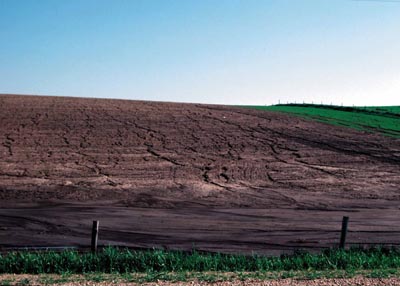Competency Area 5: Soil conservation AEM
PO 39. Understand the three stages of soil erosion and their relation to soil properties.
The three stages of soil erosion are: dislodgement, transportation, andsedimentation. Silt is usually preferentially dislodged and transported because clay particles tend to be flocculated and combined in aggregates which increase their mass, and sand particles are larger and heavy.
Aggregation of course also affects this process: a well-aggregated soil is less sensitive to dislodgement and transportation than a poorly aggregated soil. Soil cover dramatically affects dislodgement by protecting the soil from raindrop impact.
Soil cover also reduces transportation by providing physical barriers and opportunities for ponding and velocity reduction. Infiltration affects transportation. Hence a soil with high infiltration will have less transportation.
Sedimentation occurs when the velocity and carrying capacity of runoff decreases. This may happen if soils change in slope or infiltration capacity.

Soil erosion on a hillside
image source: http://instruct1.cit.cornell.edu/Courses/css412/mod4/ext_m4_pg7.htm
Quick Links
- Competency Area 1: Basic soil properties
- Competency Area 2: Soil hydrology AEM
- Competency Area 3: Drainage and irrigation AEM
- Competency Area 4: Soil health and compaction
- Competency Area 5: Soil conservation AEM
- Competency Area 6: Watershed hydrology AEM
- Competency Area 7: Non-point source pollution AEM
- Competency Area 8: Concentrated source pollution AEM
- Competency Area 9: Conservation planning AEM
